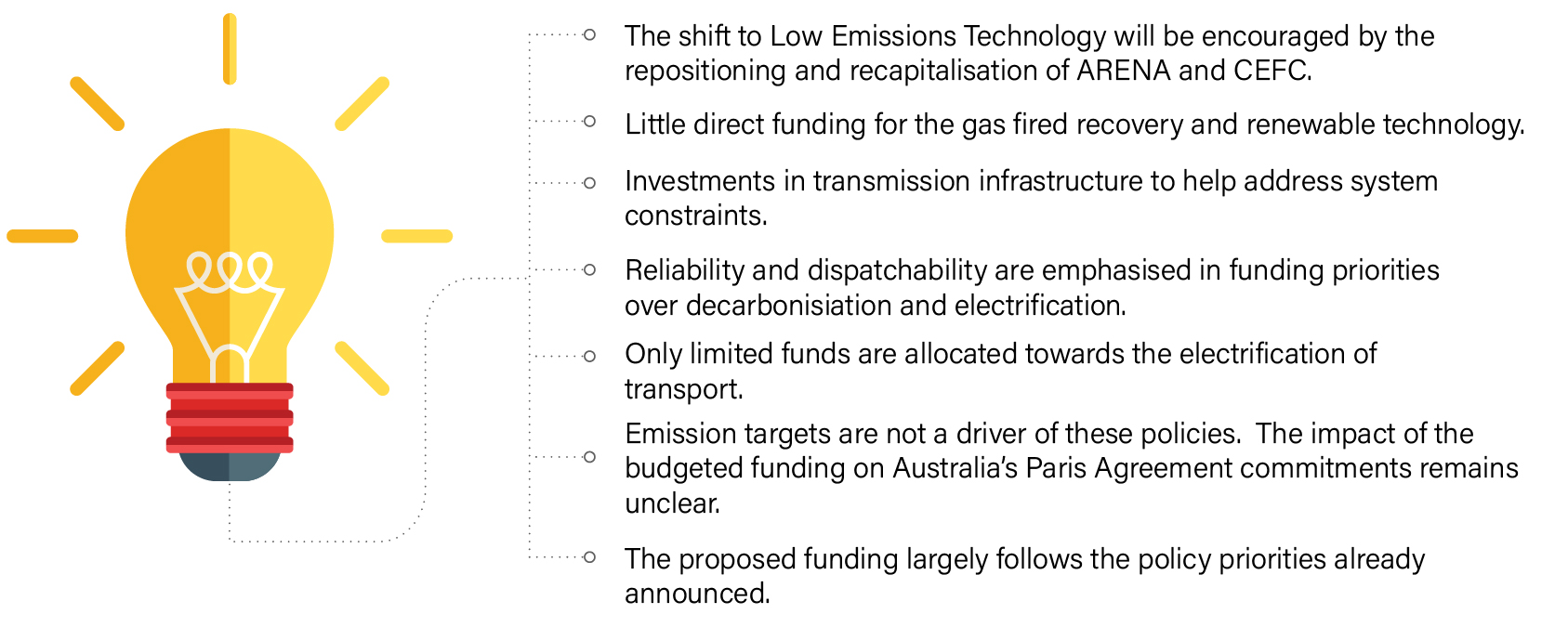Key takeaways

After some period of apparent policy gridlock, in the last few weeks the Australian Government has made a number of announcements setting out its pathway for the energy transition.
Taken together, the key aspects of this plan as announced are investment in priority technologies as set out in its Low Emissions Technology Statement issued in September, the development of gas as a transitional fuel and the repositioning and recapitalisation of Australian Renewable Energy Agency (ARENA) and the Clean Energy Finance Corporation (CEFC) to drive development and investments in the priority technologies.
For energy transition investors seeking policy stability and a recognition of the systemic issues which have resulted in steep declines in investment over the last 24 months this has been welcome.
This week the Government released their delayed 2020-21 Budget. A critical question for investors is how these announcements have been reflected in the budget priorities.
The shift to Low Emissions Technology will be encouraged by the repositioning and recapitalisation of ARENA and CEFC
As anticipated, the budget confirmed the provision of $1.9 billion over 12 years from 2020-21 to support research, development and investment in the five priority technologies being clean hydrogen, energy storage, both low-emissions steel and aluminium, carbon capture and storage and soil carbon.
The budget further identifies that over that 12 year period $1.4 billion of that will go to ARENA, with a direction to prioritise investment in the research and development of technologies related to Low Emission Technologies.
To deliver on this directive ARENA will have its investment remit expanded and will (together with the Clean Energy Regulator) oversee the deployment of part of the $2 billion Climate Solutions Fund (formerly the Energy Reductions Fund). The detail on this aspect is still to come.
Like ARENA, CEFC will have its remit expanded to facilitate investment in Low Emission Technologies and will no longer be required to ensure that half of its investments are in renewable energy.
Consistent with the Low Emissions Technology Statement the Government is providing little direct funding for the gas fired recovery and renewable technology.
Despite centring part of its energy policies on a gas-fired recovery plan, most funding has gone towards accelerating the development of new and emerging technologies such as hydrogen and carbon capture (see the table below).
Only $52.9 million over four years has been set aside for gas related infrastructure investments.
However a further $134.7 million has been allocated to fund dispatchable generation and reliable energy supplies. This should also be seen in the context of a budgeted investment of $1.5 billion over five years to support a Modern Manufacturing Strategy, which the Government has flagged it anticipates will need to be powered by gas in the short to medium term.
There is no additional direct support for renewable energy technologies.
Significant funding has been allocated to addressing system constraints by investment in transmission infrastructure and reliability
While no direct investment has been allocated to renewable energy, funding of up to $250 million for the VNI West project connecting Victoria and New South Wales, Project EnergyConnect (between South Australia and New South Wales) and the Marinus Link Project (between Tasmania and Victoria) is an important step to this transmission infrastructure being built and creating the system capacity to allow additional renewable energy projects to connect to the network. It will also help address an important constraint on investment in the sector.
In addition the CEFC maintains its mandate to manage the $1 billion Grid Reliability Fund. To be eligible to access this fund a project will to need to fall within one of the following categories:
- energy storage (including pumped hydro and batteries),
- transmission and distribution infrastructure and grid stabilising technologies.
An unspecified amount has also been allocated to upgrade the coal fired Vales Point Power Station presumably consistent with the Government’s stated aim of ensuring there is sufficient ‘dispatchable’ supply in the network to ameliorate the imminent retirement of the Liddell plant.
Limited funds have been allocated towards the electrification of transport
A common theme of initial energy sector commentary on the budget has been the relative lack of funding available to support the electrification of transport with $74.5 million over four years being earmarked to assist businesses to integrate new vehicle technologies, perform integration analysis and develop improved information on electric vehicles and charging infrastructure and $5 million to establish an electric vehicle manufacturing and assembly facility in South Australia.
The impact of the budgeted funding on Australia’s Paris Agreement commitments remains unclear
Perhaps consistent with its position of de-emphasising of emissions targets, the Government has not indicated whether the budgeted funding associated with the Low Emissions Technology Statement will assist Australia to meet its commitments made pursuant the Paris Agreement to reduce greenhouse gas emissions to 26-28% below 2005 levels.
However, given the priority technologies supported in the Low Emissions Technology Statement, it is unclear how Australia’s Paris Agreement commitments will be facilitated or progressed.
Further, in the context of the catastrophic bushfires of 2020, there was a relatively modest investment in environmental protection of $1.8 billion over 5 years.
The Government has previously indicated its unwillingness to commit to a zero net emissions target with this budget not providing anything further to support this either way.
Energy sector budget outcomes at a glance
| Policy |
Funding |
| Improving energy affordability and reliability |
| Support investment in dispatchable generation and reliable energy supplies in the National Electricity Market |
Up to $134.7 million over four years |
| Fund the VNI West, Project EnergyConnect and the Marinus Link Project |
Undisclosed due to commercial sensitivities (but up to $250 million) |
| Upgrade Delta Electricity’s Vales Point Power Station |
Undisclosed due to commercial sensitivities |
| Investment in new energy technologies |
| Create the Future Fuels Fund to enable businesses to integrate new vehicle technologies, perform integration analysis and develop improved information on electric vehicles and charging infrastructure |
$74.5 million over four years |
| Create a co-investment fund that supports industrial, freight and agricultural businesses to identify and adopt technologies to reduce emissions |
$95.4 million over six years |
| Providing funding to establish an electric vehicle manufacturing and assembly facility in South Australia |
$5 million over one year |
| Support the development of a technology neutral regional hydrogen export hub to boost regional economies |
$70.2 million over five years |
| Establish the Commonwealth Carbon Capture Use and Storage Development Fund for research into reducing the abatement of energy generators |
$50 million over three years |
| Expand the Regional and Remote Communities Reliability Fund to support pilot studies for microgrids in regional and remote areas |
$67.1 million over six years |
| Improve productivity and lower energy costs in the building and hotels sector |
$52.2 million over five years |
| Improve energy and emissions data analytics, tools and reporting to better support the Government’s commitment to deliver affordable and reliable energy |
$25.3 million over four years |
| Create an ongoing Technology Investment Advisory Council |
$5.2 million over four years |
| Gas-fired recovery |
| Support a gas-fired recovery unlocking gas supply, delivering an efficient pipeline and transportation market, and empowering gas customers, including developing a National Gas Infrastructure Plan |
$52.9 million over four years |
Securing Australia’s liquid fuel stocks
|
| Invest in new diesel fuel storage facilities, including a competitive grants program to support the constructions of new diesel fuel storage |
$250.7 million over ten years |
| Modern Manufacturing Strategy |
| Support the Modern Manufacturing Strategy focussed on building competitiveness, scale and resilience in the Australian manufacturing sector |
$1.5 billion over five years |
| Growing Australia’s Waste and Recycling Capability Through Cooperative Research Centre Projects |
| Support collaborative research projects through the Cooperative Research Centres Projects program to develop solutions for recycling and reuse of plastics, paper, tyres and other materials |
$10 million over four years |
| Deregulation package |
|
Provide the Clean Energy Regulator with funding to:
- establish a new exchange platform for emissions reductions units.
- reduce timeframes for project registration and crediting under the Emissions Reduction Fund through streamlined digital infrastructure.
- reduce the time it takes to develop new methods.
|
$40.4 million over ten years |
| Engagement with State and Territory Governments on regulatory reforms |
| Continue engaging with state and territory governments to progress priority energy reforms as agreed by National Cabinet and deliver the 2025 National Electricity Market design process |
$5.4 million over one year |
| Support the development of a regulatory framework for offshore clean energy infrastructure industry |
$4.8 million over two years |
| Support the development and implementation of Energy and Emissions Reduction State Deals |
$3.7 million over four years |
| |
|















